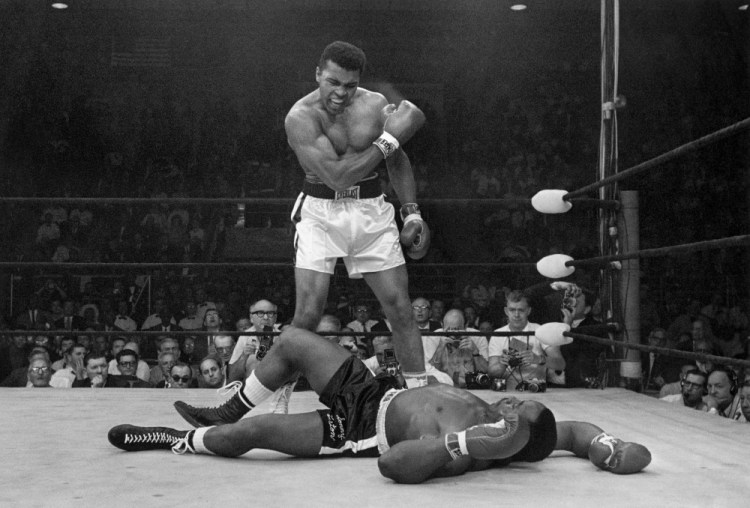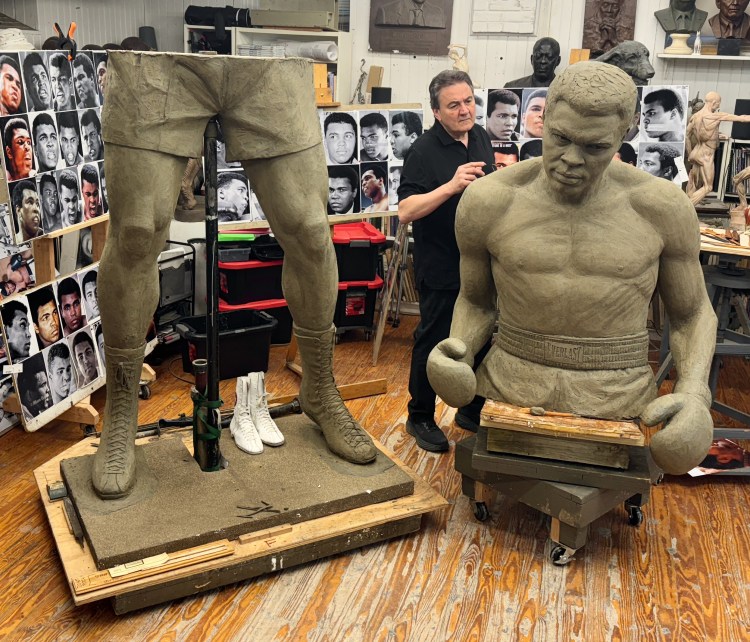LEWISTON — A 10-foot bronze statue of Muhammad Ali is on track to be unveiled May 25 in Lewiston, sculptor Zenos Frudakis said Thursday.
Construction of the statue’s 3-foot base is set to wrap up this week in front of Bates Mill No. 5 at 65 Main St.
The statue is to depict the world heavyweight boxing champion standing victoriously in the aftermath of his 1965 knockout of Sonny Liston at what is now called The Colisée.
Frudakis said the statue will show Ali in a slightly different pose — “a little bit more timeless” — than the iconic 1965 photograph “where he’s got this hand across his chest and he’s looking down at Liston.”

“I thought, first of all, it’s a shame to cover his chest,” Frudakis said. “He had a beautiful figure, body and chest and everything. But more importantly, I didn’t want to try and copy somebody else’s photograph, which they really owned. It’s a combination of a couple photos that I saw. It’s not any one photo.”
The new pose is a nod to Ali’s unique fighting style, according to Frudakis.
“Ali often fought with his arms down a little bit, which very few fighters ever did,” he said. “He was so fast. He could bring his arms up, or he could back up on his heel and just have the fighter miss him by a split inch or a fraction of an inch.”

“Even though Liston is not there, it is suggested that he’s there, that Ali’s adversary has fallen, like David and Goliath,” Frudakis said.
The 10-foot statue began as a 24-inch flexible model “with a little aluminum-wired skeleton inside it,” Frudakis said. “The concept alone took months of back and forth. I was working on a 24-inch model. When you have a small model, you can easily adjust the armature.”

The Pennsylvania-based sculptor is credited with more than 100 bronze monuments and statues of prominent figures, including James J. Braddock, an American world heavyweight boxing champion in the mid-1930s.
“I’ve always been a fan. I’ve admired Ali,” Frudakis said. “When someone calls you and says, ‘There’s an opportunity here to have a statue made and you can make it,’ you jump in the ring.”
The statue will be tied in a way to many other monuments and iconic statues across the country, Frudakis said.
“The clay I use is over 100 years old,” he said. “Some of it was used to make the Lincoln Memorial and some other sculptures around. It gets passed down from sculptor to sculptor. It’s not made anymore. I have old sculpture tools from sculptors who were prominent in the past. I’m using it all. They’re all, in a way, part of history.”
Local artist Charlie Hewitt recruited Frudakis in 2018. Hewitt serves as the statue project’s executive producer and is involved with a film that will recount the story of the fight.
“How in the world does the biggest fight of the century end up in Lewiston, Maine?” Hewitt said. “That’s part of the story we’re going to tell.
“In 1924, a 10-foot cross was burned in the town of Lewiston. It was set up by the Ku Klux Klan to intimidate and terrorize the French Canadian people. And that has created a racial trauma that still exists, I think, up there today.
“This year, a 10-foot statue is being brought to Lewiston, celebrating the good nature of all of us. I think there’s something very poetic about it.”

Comments are no longer available on this story